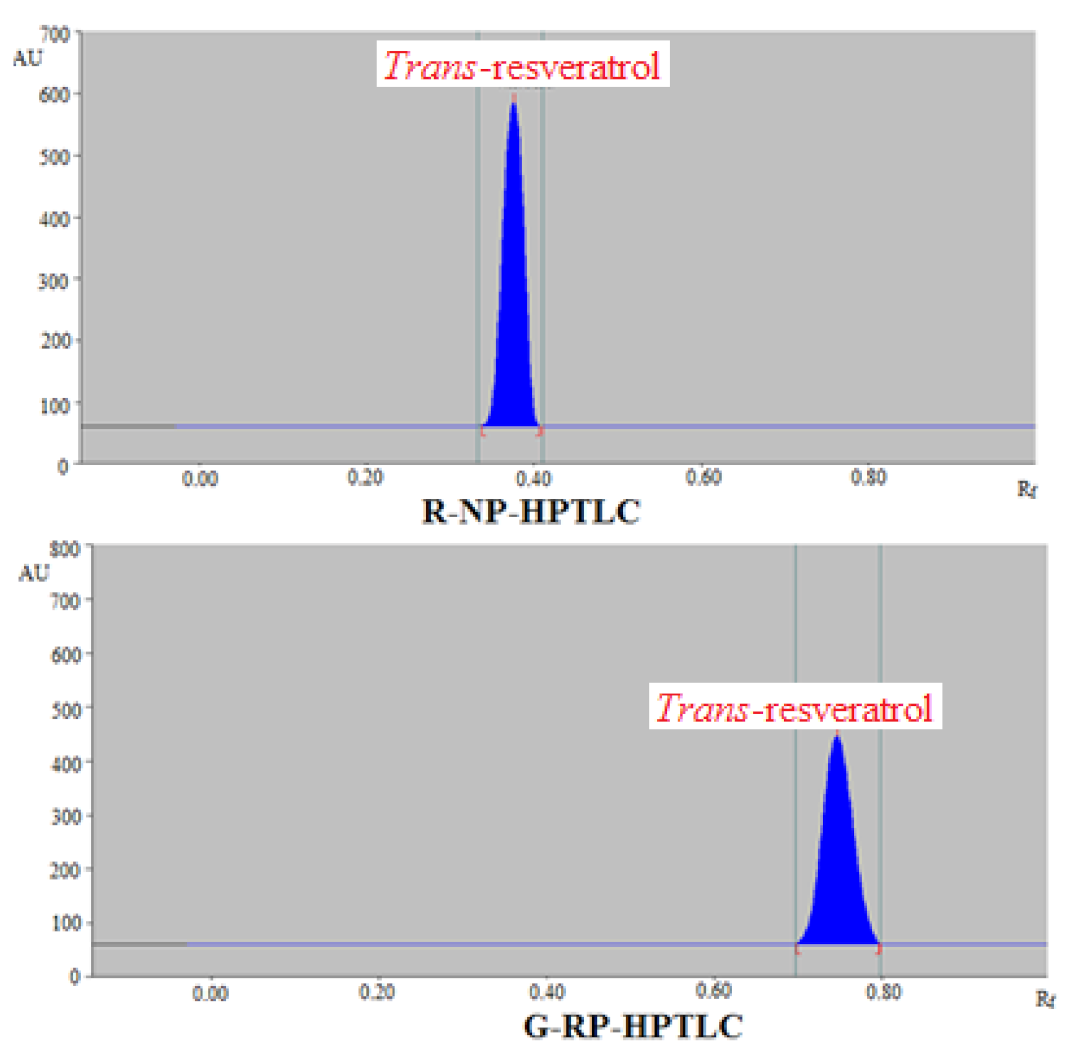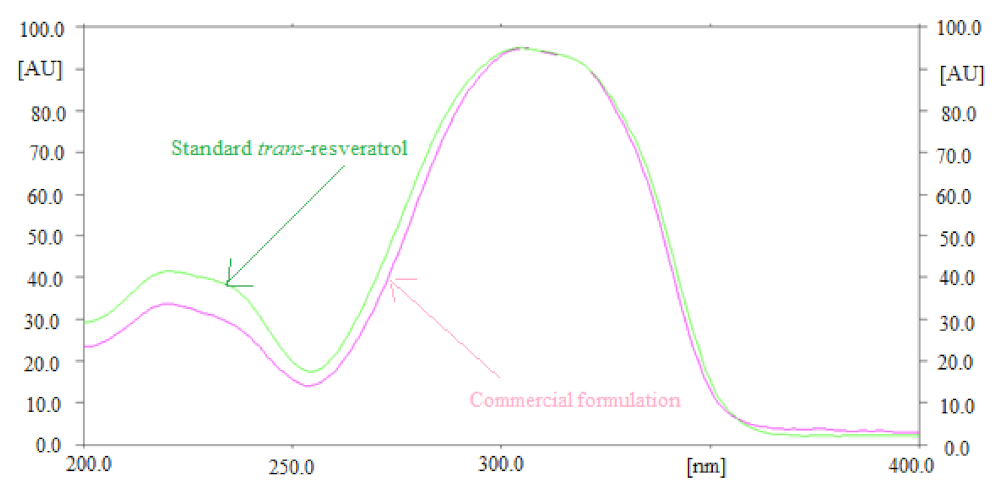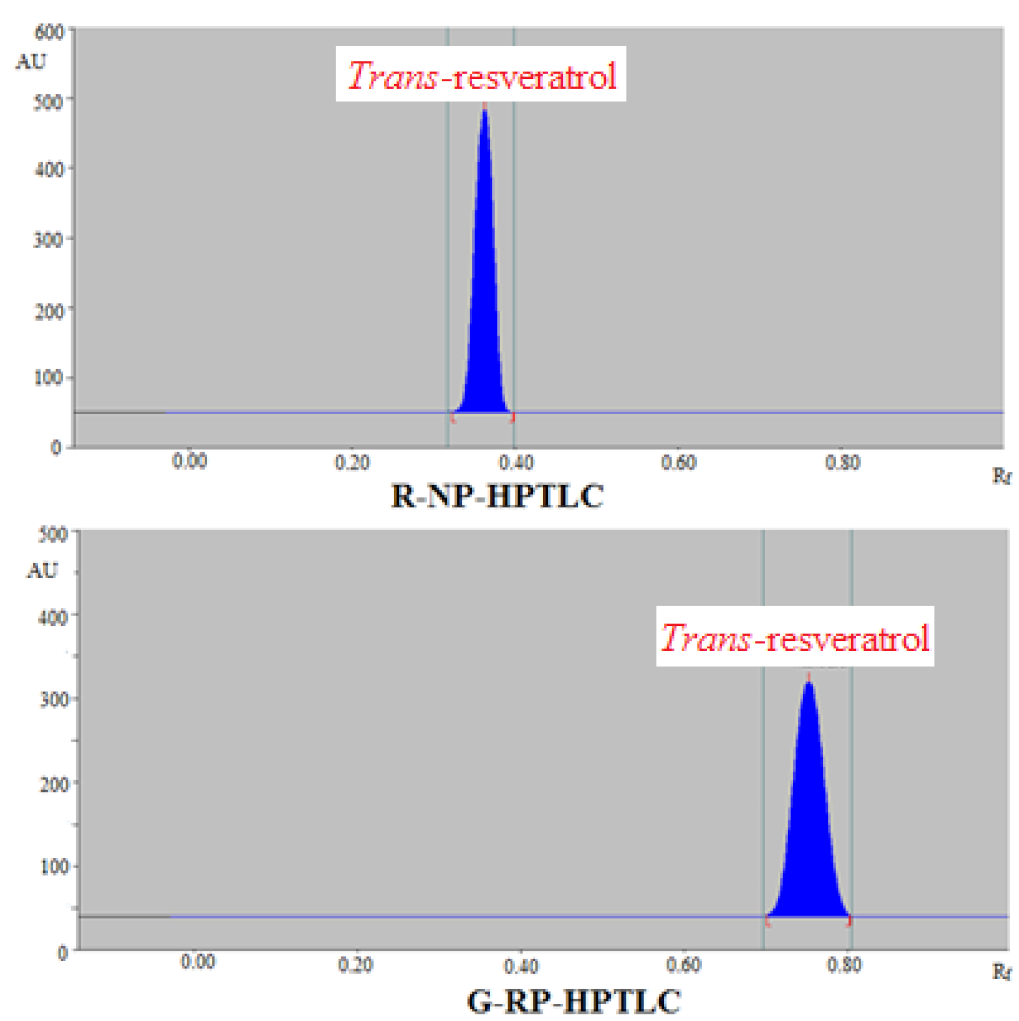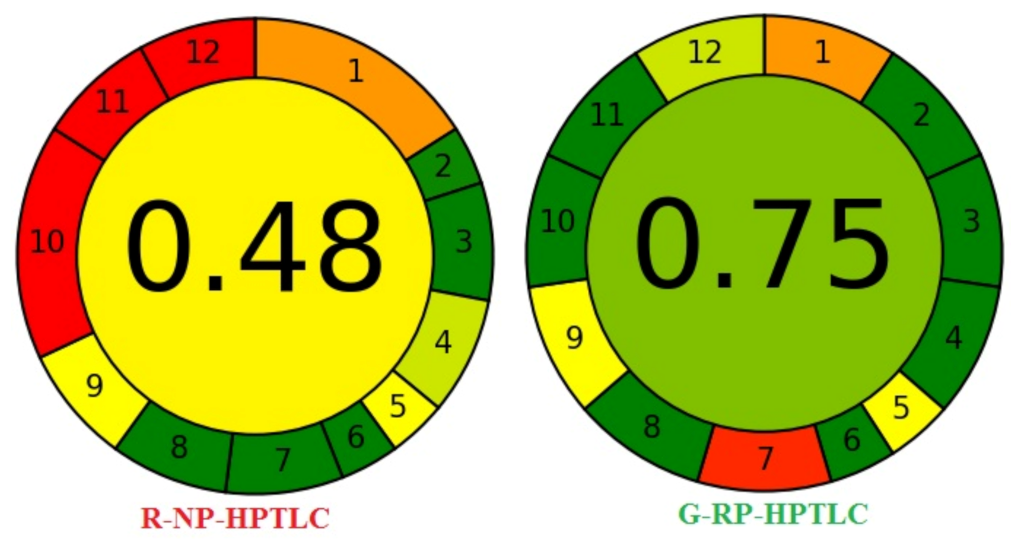Rapid, Highly-Sensitive and Ecologically Greener Reversed-Phase/Normal-Phase HPTLC Technique with Univariate Calibration for the Determination of Trans-Resveratrol
Abstract
1. Introduction
2. Materials and Methods
2.1. Materials
2.2. Chromatography and Analytical Conditions
2.3. TRV Univariate Calibration Curve
2.4. Sample Processing for the Quantification of TRV in Commercial Formulations
2.5. Validation Parameters
2.6. Quantification of TRV in Marketed Formulations
2.7. Greenness Evaluation Using AGREE
3. Results and Discussion
3.1. Method Development
3.2. Validation Parameters
3.3. Quantification of TRV in Marketed Capsule Dosage Forms
3.4. Evaluation of Greenness Profile Using AGREE
3.5. Comparison with Reported Techniques
4. Conclusions
Supplementary Materials
Author Contributions
Funding
Data Availability Statement
Acknowledgments
Conflicts of Interest
References
- Caddeo, C.; Nacher, A.; Vassallo, A.; Armentano, M.F.; Pons, R.; Fernàndez-Busquets, X.; Carbone, C.; Valenti, D.; Fadda, A.M.; Manconi, M. Effect of quercetin and resveratrol co-incorporated in liposomes against inflammatory/oxidative response associated with skin cancer. Int. J. Pharm. 2016, 513, 153–163. [Google Scholar] [CrossRef]
- Lee, K.W.; Bode, A.M.; Dong, Z. Molecular targets of phytochemicals for cancer prevention. Nat. Rev. Cancer 2011, 11, 211–218. [Google Scholar] [CrossRef]
- Imran, M.; Iqubal, M.K.; Ahmad, S.; Ali, J.; Baboota, S. Stability-indicating high-performance thin-layer chromatographic method for the simultaneous determination of quercetin and resveratrol in the lipid-based nanoformulation. J. Planar Chromatogr. 2019, 32, 393–400. [Google Scholar] [CrossRef]
- Babu, S.K.; Kumar, K.V.; Subbaraju, G.V. Estimation of trans-resveratrol in herbal extracts and dosage forms by high-performance thin-layer chromatography. Chem. Pharm. Bull. 2005, 53, 691–693. [Google Scholar] [CrossRef][Green Version]
- Gulcin, I. Antioxidant properties of resveratrol: A structure-activity insight. Innov. Food Sci. Emerg. Technol. 2010, 11, 210–218. [Google Scholar] [CrossRef]
- Zhou, Z.X.; Mou, S.F.; Chen, X.Q.; Gong, L.L.; Ge, W.S. Anti-inflammatory activity of resveratrol prevents inflammation by inhibiting NF-kB in animal models of acute pharyngitis. Mol. Med. Rep. 2018, 17, 1269–1274. [Google Scholar] [PubMed]
- Jang, M.; Cai, L.; Udeani, G.O.; Slowing, K.V.; Thomas, C.F.; Beecher, C.W.W.; Fong, H.H.S.; Farnsworth, N.R.; Kinghorn, A.D.; Mehta, R.G.; et al. Cancer chemopreventive activity of resveratrol a natural product derived from grapes. Science 1997, 275, 218–220. [Google Scholar] [CrossRef] [PubMed]
- Park, C.S.; Lee, Y.C.; Kim, J.D.; Kim, C.H. Inhibitory effects of Polygonum cuspidatum water extract (PCWE) and its component resveratrol [correction of rasveratrol] on acyl-coenzyme A-cholesterol acyltransferase activity for cholesteryl ester synthesis in HepG2 cells. Vasc. Pharmacol. 2004, 40, 279–284. [Google Scholar] [CrossRef] [PubMed]
- Cote, B.; Carlson, L.J.; Rao, D.A.; Alani, A.W.G. Combination of resveratrol and quercetin polymeric micelles mitigates doxorubicin induced cardiotoxicity in vitro and in vivo. J. Control. Release 2015, 213, 128–133. [Google Scholar] [CrossRef]
- Rao, Y.L.; Ganaraja, B.; Joy, T.; Pai, M.M.; Ullal, S.D.; Murlimanju, B.V. Neuroprotective effects of resveratrol in Alzheimer’s disease. Front. Biosci. 2020, 12, 130–149. [Google Scholar]
- Singh, G.; Pai, R.S. A rapid reversed-phase HPLC method for analysis of trans-resveratrol in PLGA nanoparticulate formulation. ISRN Chromatogr. 2014, 2014, E248635. [Google Scholar] [CrossRef]
- Nasr, M.; Rahman, M.H.A. Simultaneous determination of curcumin and resveratrol in lipidic nanoemulsion formulation and rat plasma using HPLC: Optimization and application to real samples. J. AOAC Int. 2019, 402, 1095–1101. [Google Scholar] [CrossRef]
- Jagwani, S.; Jalalpure, S.; Dhamecha, D.; Hua, G.S.; Jadhav, K. A stability indicating reversed phase HPLC method for estimation of trans-resveratrol in oral capsules and nanoliposomes. Anal. Chem. Lett. 2019, 9, 711–726. [Google Scholar] [CrossRef]
- Xu, S.; Luo, H.; Chen, H.; Guo, J.; Yu, B.; Zhang, H.; Li, W.; Chen, W.; Zhou, X.; Huang, L.; et al. Optimization of extraction of total trans-resveratrol from peanut seeds and its determination by HPLC. J. Sep. Sci. 2020, 43, 1024–1031. [Google Scholar] [CrossRef] [PubMed]
- Souto, A.A.; Carneiro, M.C.; Seferin, M.; Senna, M.J.H.; Conz, A.; Gobbi, K. Determination of trans-resveratrol in Brazilian red wines by HPLC. J. Food Compos. Anal. 2001, 14, 441–445. [Google Scholar] [CrossRef]
- Kolouchova-Hanzlikova, I.; Melzoch, K.; Filip, V.; Smidrkal, J. Rapid method for resveratrol determination by HPLC with electrochemical and UV detections in wines. Food Chem. 2004, 87, 151–158. [Google Scholar] [CrossRef]
- Ratola, N.; Faria, J.L.; Alves, A. Analysis and quantification of trans-resveratrol in wines from Alentejo region (Portugal). Food Technol. Biotechnol. 2004, 42, 125–130. [Google Scholar]
- Cvejic, J.M.; Djekic, S.V.; Petrovic, A.V.; Atanackovic, M.T.; Jovic, S.M.; Brceski, I.D.; Gojkovic-Bukarica, L.C. Determination of a trans- and cis-resveratrol in Serbian commercial wines. J. Chromatogr. Sci. 2010, 48, 229–234. [Google Scholar] [CrossRef] [PubMed]
- da Silva, L.F.; Guerra, C.C.; Czermainski, A.B.C.; Ferrari, L.; Bergold, A.M. Validation of a chromatographic method to routine analysis of trans-resveratrol and quercetin in red wines. Pesq. Agropec. Bras. Bras. 2017, 51, 335–343. [Google Scholar] [CrossRef][Green Version]
- Juan, M.E.; Lamuela-Raventos, R.M.; Torre-Boronat, C.D.M.L.; Planas, J.M. Determination of trans-resveratrol in plasma by HPLC. Anal. Chem. 1999, 71, 747–750. [Google Scholar] [CrossRef]
- Katsagonis, A.; Atta-Politou, J.; Koupparis, M.A. HPLC method with UV detection for the determination of trans-resveratrol in plasma. J. Liq. Chromatogr. Relat. Technol. 2005, 28, 1393–1405. [Google Scholar] [CrossRef]
- Chen, X.; He, H.; Wang, G.; Yang, B.; Ren, W.; Ma, L.; Yu, Q. Stereospecific determination of cis- and trans-resveratrol in rat plasma by HPLC: Application to pharmacokinetic studies. Biomed. Chromatogr. 2007, 21, 257–265. [Google Scholar] [CrossRef]
- Singh, G.; Pai, R.S.; Pandit, V. Development and validation of a HPLC method for the determination of trans-resveratrol in spiked human plasma. J. Adv. Pharm. Technol. Res. 2012, 3, 130–135. [Google Scholar]
- Biasutto, L.; Marotta, E.; Garbisa, S.; Zoratti, M.; Paradisi, C. Determination of quercetin and resveratrol in whole blood-implications for bioavailability studies. Molecules 2010, 15, 6570–6579. [Google Scholar] [CrossRef]
- Omar, J.M.; Yang, H.; Li, S.; Marquartd, R.R.; Jones, P.J.H. Development of an improved reverse-phase high-performance liquid chromatography method for the simultaneous analyses of trans-/cis-resveratrol, quercetin, and emodin in commercial resveratrol supplements. J. Agric. Food Chem. 2014, 62, 5812–5817. [Google Scholar] [CrossRef] [PubMed]
- Brizzi, A.; Brizzi, V.; Corradini, D. Identification and quantification of trans-resveratrol in dietary supplements by a rapid and straightforward RP-HPLC method. J. Liq. Chromatogr. Relat. Technol. 2008, 31, 2089–2100. [Google Scholar] [CrossRef]
- Breeman, R.V.; Bzhelyansky, A.; Es-Safi, N.E.; Jennens, M.; Johnson, H.E.; Krepich, S.; Kuszak, A.; Monagas, M.; Reif, K.; Rimmer, C.A.; et al. Standard method performance requirements (SMPRs®) 2018.004: Determination of trans resveratrol in dietary supplements and dietary ingredients. J. AOAC Int. 2018, 101, 1254–1255. [Google Scholar] [CrossRef]
- Ares, A.M.; Soto, M.E.; Nozal, M.J.; Bernal, J.L.; Higes, M.; Bernal, J. Determination of resveratrol and piceid isomers in bee pollen by liquid chromatography coupled to electrospray ionization-mass spectrometry. Food Anal. Methods 2015, 8, 1565–1575. [Google Scholar] [CrossRef]
- Vlase, L.; Kiss, B.; Leucuta, S.E.; Gocan, S. A rapid method for determination of resveratrol in wines by HPLC-MS. J. Liq. Chromatogr. Relat. Technol. 2009, 32, 2105–2121. [Google Scholar] [CrossRef]
- Su, M.X.; Di, B.; Hang, T.J.; Wang, J.; Yang, D.S.; Wang, T.H.; Meng, R. Rapid, sensitive and selective analysis of trans-resveratrol in rat plasma by LC-MS-MS. Chromatographia 2011, 73, 1203–1210. [Google Scholar] [CrossRef]
- Muzzio, M.; Huang, Z.; Hu, S.C.; Johnson, W.D.; McCormick, D.L.; Kapetanovic, I.M. Determination of resveratrol and its sulfate and glucuronide metabolites in plasma by LC-MS/MS and their pharmacokinetics in dogs. J. Pharm. Biomed. Anal. 2012, 59, 201–208. [Google Scholar] [CrossRef] [PubMed]
- Lotz, A.; Milz, B.; Spangenberg, B. A new and sensitive TLC to measure trans-resveratrol in red wine. J. Liq. Chromatogr. Relat. Technol. 2015, 38, 1104–1108. [Google Scholar] [CrossRef]
- Malele, R.S.; Zvikomborero, M.C. Estimation of trans-resveratrol in grape berry skin extract by high-performance thin-layer chromatography (HPTLC). Int. J. Res. Health Sci. 2014, 2, 213–223. [Google Scholar]
- Pillai, D.; Pandita, N. Validated high-performance thin-layer chromatography method for quantification of bioactive marker compounds in Draksharishta, an ayurvedic polyherbal formulation. Rev. Bras. Pharmacog. 2016, 26, 558–563. [Google Scholar] [CrossRef][Green Version]
- Paul, A.; Rajiung, M.; Zaman, K.; Chaudhary, S.K.; Shakya, A. Quantification of the bioactive resveratrol in Morus alba Linn. fruits by high-performance thin-layer chromatography. J. Planar Chromatogr. 2020, 33, 481–487. [Google Scholar] [CrossRef]
- Goldberg, D.M.; Yan, J.; Ng, E.; Diamandis, E.P.; Karumanchiri, A.; Soleas, G.; Waterhouse, A.L. Direct injection gas chromatographic mass spectrometric assay for trans-resveratrol. Anal. Chem. 1994, 66, 3959–3963. [Google Scholar] [CrossRef]
- Gu, X.; Creasy, L.; Kester, A.; Zeece, M. Capillary electrophoretic determination of resveratrol in wines. J. Agric. Food Chem. 1999, 47, 3223–3227. [Google Scholar] [CrossRef]
- Liu, L.; Zhou, Y.; Kang, Y.; Huang, H.; Li, C.; Xu, M.; Ye, B. Electrochemical evaluation of trans-resveratrol levels in red wines based on the interaction between resveratrol and grapheme. J. Anal. Methods Chem. 2017, 2017, E5749025. [Google Scholar] [CrossRef]
- Li, C.P.; Tan, S.; Ye, H.; Cao, J.; Zhao, H. A novel fluorescence assay for resveratrol determination in red wine based on competitive host-guest interaction. Food Chem. 2019, 283, 191–198. [Google Scholar] [CrossRef]
- Foudah, A.I.; Alam, P.; Anwer, M.K.; Yusufoglu, H.S.; Abdel-Kader, M.S.; Shakeel, F. A green RP-HPTLC-densitometry method for the determination of diosmin in pharmaceutical formulations. Processes 2020, 8, 817. [Google Scholar] [CrossRef]
- Bhandari, P.; Kumar, N.; Gupta, A.P.; Singh, B.; Kaul, V.K. A rapid RP-HPTLC densitometry method for simultaneous determination of major flavonoids in important medicinal plants. J. Sep. Sci. 2007, 30, 2092–2096. [Google Scholar] [CrossRef] [PubMed]
- Sharma, U.K.; Sharma, N.; Gupta, A.P.; Kumar, V.; Sinha, A.K. RP-HPTLC determination and validation of vanillin and related phenolic compounds in accelerated solvent extract of Vanilla planifolia. J. Sep. Sci. 2007, 30, 3174–3180. [Google Scholar] [CrossRef] [PubMed]
- Alam, P.; Shakeel, F.; Alqarni, M.H.; Foudah, A.I.; Faiyazuddin, M.; Alshehri, S. Rapid, sensitive, and sustainable reversed-phase HPTLC method in comparison to the normal-phase HPTLC for the determination of pterostilbene in capsule dosage form. Processes 2021, 9, 1305. [Google Scholar] [CrossRef]
- Foudah, A.I.; Shakeel, F.; Alqarni, M.H.; Yusufoglu, H.S.; Salkini, M.A.; Alam, P. Determination of trans-anethole in essential oil, methanolic extract and commercial formulations of Foeniculum vulgare Mill using a green RP-HPTLC-densitometry method. Separations 2020, 7, 51. [Google Scholar] [CrossRef]
- Foudah, A.I.; Shakeel, F.; Yusufoglu, H.S.; Ross, S.A.; Alam, P. Simultaneous determination of 6-shogaol and 6-gingerol in various ginger (Zingiber officinale Roscoe) extracts and commercial formulations using a green RP-HPTLC-densitometry method. Foods 2020, 9, 1136. [Google Scholar] [CrossRef] [PubMed]
- Abdelrahman, M.M.; Abdelwahab, N.S.; Hegazy, M.A.; Fares, M.Y.; El-Sayed, G.M. Determination of the abused intravenously administered madness drops (tropicamide) by liquid chromatography in rat plasma; an application to pharmacokinetic study and greenness profile assessment. Microchem. J. 2020, 159, E105582. [Google Scholar] [CrossRef]
- Duan, X.; Liu, X.; Dong, Y.; Yang, J.; Zhang, J.; He, S.; Yang, F.; Wang, Z.; Dong, Y. A green HPLC method for determination of nine sulfonamides in milk and beef, and its greenness assessment with analytical eco-scale and greenness profile. J. AOAC Int. 2020, 103, 1181–1189. [Google Scholar] [CrossRef]
- Pena-Pereira, F.; Wojnowski, W.; Tobiszewski, M. AGREE-Analytical GREEnness metric approach and software. Anal. Chem. 2020, 92, 10076–10082. [Google Scholar] [CrossRef]
- Foudah, A.I.; Shakeel, F.; Alqarni, M.H.; Alam, P. A rapid and sensitive stability-indicating green RP-HPTLC method for the quantitation of flibanserin compared to green NP-HPTLC method: Validation studies and greenness assessment. Microchem J. 2021, 164, E105960. [Google Scholar] [CrossRef]
- Alam, P.; Salem-Bekhit, M.M.; Al-Joufi, F.A.; Alqarni, M.H.; Shakeel, F. Quantitative analysis of cabozantinib in pharmaceutical dosage forms using green RP-HPTLC and green NP-HPTLC methods: A comparative evaluation. Sustain. Chem. Pharm. 2021, 21, E100413. [Google Scholar] [CrossRef]
- Foudah, A.I.; Shakeel, F.; Alqarni, M.H.; Ross, S.A.; Salkini, M.A.; Alam, P. Simultaneous estimation of cinnamaldehyde and eugenol in essential oils and traditional and ultrasound-assisted extracts of different species of cinnamon using a sustainable/green HPTLC technique. Molecules 2021, 26, 2054. [Google Scholar] [CrossRef]
- Foudah, A.I.; Shakeel, F.; Alam, P.; Alqarni, M.H.; Abdel-Kader, M.S.; Alshehri, S. A sustainable reversed-phase HPTLC method for the quantitative estimation of hesperidin in traditional and ultrasound-assisted extracts of different varieties of citrus fruit peels and commercial tablets. Agronomy 2021, 11, 1744. [Google Scholar] [CrossRef]
- Alqarni, M.H.; Alam, P.; Foudah, A.I.; Muharram, M.M.; Shakeel, F. Combining normal/reversed-phase HPTLC with univariate calibration for the piperine quantification with traditional and ultrasound-assisted extracts of various food spices of Piper nigrum L. under green analytical chemistry viewpoint. Molecules 2021, 26, 732. [Google Scholar] [CrossRef] [PubMed]
- Foudah, A.I.; Shakeel, F.; Alqarni, M.H.; Ross, S.A.; Salikini, M.A.; Alam, P. Green NP-HPTLC and green RP-HPTLC methods for the determination of thymoquinone: A contrast of validation parameters and greenness assessment. Phytochem. Anal. 2021. [Google Scholar] [CrossRef]
- International Conference on Harmonization (ICH). Q2 (R1): Validation of Analytical Procedures–Text and Methodology; International Conference on Harmonization (ICH): Geneva, Switzerland, 2005. [Google Scholar]
- Escandar, G.M.; Goicoechea, H.C.; Pena, A.D.M.L.; Olivieri, A.C. Second- and higher-order data generation and calibration: A tutorial. Anal. Chim. Acta 2014, 806, 8–26. [Google Scholar] [CrossRef] [PubMed]
- Mazivila, S.J.; Ricardo, I.A.; Leitao, J.M.M.; da Silva, J.C.J.E. A review on advanced oxidation process: From classical to new perspectives coupled to two- and multi-way strategies to monitor degradation of contaminants in environmental samples. Trends Environ. Anal. Chem. 2019, 24, e00072. [Google Scholar] [CrossRef]




| Parameters | R-NP-HPTLC | G-RP-HPTLC |
|---|---|---|
| Linearity range (ng band−1) | 30–400 | 10–1200 |
| Regression equation | y = 34.87x + 453.32 | y = 63.53x + 26.83 |
| R2 | 0.9998 | 0.9968 |
| Slope ± SD | 34.87 ± 1.72 | 63.53 ± 1.81 |
| Intercept ± SD | 453.32 ± 5.36 | 26.83 ± 0.28 |
| Standard error of slope | 0.70 | 0.73 |
| Standard error of intercept | 2.18 | 0.11 |
| 95% confidence interval of slope | 31.84–37.89 | 60.34–66.71 |
| 95% confidence interval of intercept | 443.90–462.73 | 26.33–27.32 |
| LOD ± SD (ng band−1) | 10.84 ± 0.22 | 3.64 ± 0.10 |
| LOQ ± SD (ng band−1) | 32.52 ± 0.66 | 10.92 ± 0.30 |
| Parameters | R-NP-HPTLC | G-RP-HPTLC |
|---|---|---|
| Rf | 0.38 ± 0.01 | 0.75 ± 0.01 |
| As | 1.02 ± 0.02 | 1.04 ± 0.03 |
| N m−1 | 4672 ± 8.12 | 4598 ± 7.96 |
| Conc. (ng Band−1) | Conc. Found (ng Band−1) ± SD | Recovery (%) | CV (%) |
|---|---|---|---|
| R-NP-HPTLC method | |||
| 30 | 27.26 ± 1.25 | 90.86 | 4.58 |
| 100 | 91.31 ± 2.28 | 91.31 | 2.49 |
| 400 | 374.21 ± 4.65 | 93.55 | 1.24 |
| G-RP-HPTLC method | |||
| 10 | 10.18 ± 0.08 | 101.80 | 0.78 |
| 400 | 392.14 ± 1.58 | 98.03 | 0.40 |
| 1200 | 1189.28 ± 3.64 | 99.10 | 0.30 |
| Conc. (ng Band−1) | Intraday Precision | Intermediate | ||||
|---|---|---|---|---|---|---|
| Area ± SD | Standard Error | CV (%) | Area ± SD | Standard Error | CV (%) | |
| R-NP-HPTLC method | ||||||
| 30 | 1225 ± 42 | 17.14 | 3.42 | 1184 ± 38 | 15.51 | 3.20 |
| 100 | 4258 ± 112 | 45.73 | 2.63 | 4172 ± 120 | 48.99 | 2.87 |
| 400 | 13,984 ± 198 | 80.84 | 1.41 | 14,128 ± 216 | 88.19 | 1.52 |
| G-RP-HPTLC method | ||||||
| 10 | 764 ± 7 | 2.85 | 0.91 | 778 ± 8 | 3.26 | 1.02 |
| 400 | 25,884 ± 132 | 53.89 | 0.50 | 26,154 ± 138 | 56.34 | 0.52 |
| 1200 | 76,248 ± 312 | 127.39 | 0.40 | 75,654 ± 321 | 131.07 | 0.42 |
| Conc. (ng Band−1) | Mobile Phase Composition (Chloroform–Methanol) | Results | ||||
|---|---|---|---|---|---|---|
| Original | Used | Area ± SD | % CV | Rf | ||
| R-NP-HPTLC method | ||||||
| 87:13 | +2.0 | 4138 ± 132 | 3.18 | 0.37 | ||
| 100 | 85:15 | 85:15 | 0.0 | 4082 ± 143 | 3.50 | 0.38 |
| 83:17 | −2.0 | 3964 ± 126 | 3.17 | 0.39 | ||
| G-RP-HPTLC method | ||||||
| Mobile phase composition (ethanol–water) | ||||||
| 67:33 | +2.0 | 26,012 ± 138 | 0.49 | 0.74 | ||
| 400 | 65:35 | 65:35 | 0.0 | 25,956 ± 116 | 0.44 | 0.75 |
| 63:37 | −2.0 | 25,836 ± 113 | 0.43 | 0.76 | ||
| Analytical Method | Linearity Range | Accuracy (% Recovery) | Precision (% CV) | Ref. |
|---|---|---|---|---|
| HPTLC | 500–3000 (ng band−1) | 99.85–100.70 | 0.37–1.84 | [4] |
| HPTLC | 20–500 (ng band−1) | - | - | [32] |
| HPTLC | 50–100 (ng band−1) | 85.33–87.00 | 0.05–0.12 | [34] |
| HPTLC | 50–2500 (ng band−1) | 99.54–100.60 | 0.57–1.78 | [3] |
| HPTLC | 100–1600 (ng band−1) | 90.32–96.49 | 0.45–1.90 | [35] |
| R-NP-HPTLC | 30–400 (ng band−1) | 90.86–93.55 | 1.41–3.42 | Present work |
| G-RP-HPTLC | 10–1200 (ng band−1) | 98.03–101.80 | 0.40–1.02 | Present work |
Publisher’s Note: MDPI stays neutral with regard to jurisdictional claims in published maps and institutional affiliations. |
© 2021 by the authors. Licensee MDPI, Basel, Switzerland. This article is an open access article distributed under the terms and conditions of the Creative Commons Attribution (CC BY) license (https://creativecommons.org/licenses/by/4.0/).
Share and Cite
Alam, P.; Shakeel, F.; Alqarni, M.H.; Foudah, A.I.; Ghoneim, M.M.; Alshehri, S. Rapid, Highly-Sensitive and Ecologically Greener Reversed-Phase/Normal-Phase HPTLC Technique with Univariate Calibration for the Determination of Trans-Resveratrol. Separations 2021, 8, 184. https://doi.org/10.3390/separations8100184
Alam P, Shakeel F, Alqarni MH, Foudah AI, Ghoneim MM, Alshehri S. Rapid, Highly-Sensitive and Ecologically Greener Reversed-Phase/Normal-Phase HPTLC Technique with Univariate Calibration for the Determination of Trans-Resveratrol. Separations. 2021; 8(10):184. https://doi.org/10.3390/separations8100184
Chicago/Turabian StyleAlam, Prawez, Faiyaz Shakeel, Mohammed H. Alqarni, Ahmed I. Foudah, Mohammed M. Ghoneim, and Sultan Alshehri. 2021. "Rapid, Highly-Sensitive and Ecologically Greener Reversed-Phase/Normal-Phase HPTLC Technique with Univariate Calibration for the Determination of Trans-Resveratrol" Separations 8, no. 10: 184. https://doi.org/10.3390/separations8100184
APA StyleAlam, P., Shakeel, F., Alqarni, M. H., Foudah, A. I., Ghoneim, M. M., & Alshehri, S. (2021). Rapid, Highly-Sensitive and Ecologically Greener Reversed-Phase/Normal-Phase HPTLC Technique with Univariate Calibration for the Determination of Trans-Resveratrol. Separations, 8(10), 184. https://doi.org/10.3390/separations8100184








